Map out your brand strategy
Get all 6 free templates in the brand strategy pack.
Get startedSign up for free with no time limit

Follow this step-by-step guide to learn the modern process of developing a brand strategy in Milanote, a free tool used by top creatives.

Behind every iconic brand is a mountain of research, inspiration and ideas known as brand strategy. It's where you define everything that will make your brand unique and interesting—your ideal customer, position in the market, tone of voice, values and more. In this guide you'll learn the modern way to organize each part of a brand strategy project.
In traditional brand development projects, the insights, research and ideas might be scattered across various documents, emails, to-do lists and spreadsheets making it hard to keep track of everything. A central project plan combines these artifacts into one easy-to-access place for everyone on the team. It will evolve over the lifespan of your project but usually includes:
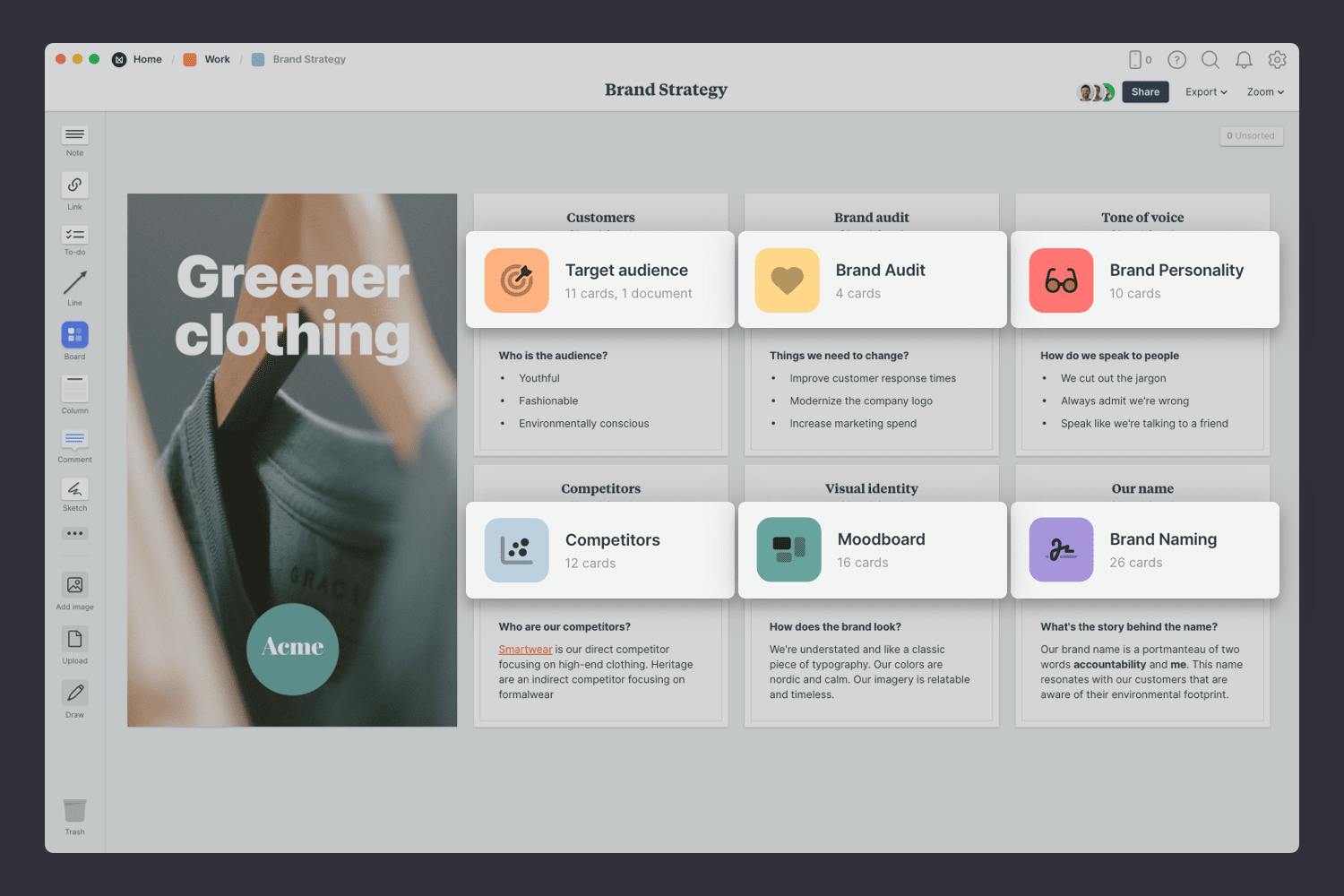
Create a new board for your project plan
Drag a board out from the toolbar. Give it a name, then double click to open it.
Choose the Brand Strategy template
Each new board gives you the option to start with a beautiful template.
If you're designing a brand from scratch you can skip this step. But, if you're redesigning an existing brand, the best place to start is by evaluating your current brand assets. A brand audit (or brand analysis) is the perfect technique for analyzing your brand in its current form. It will help you understand which elements are fundamental to your brand, and which parts feel dated and need a redesign?
Start by collecting everything in one place. Paint a clear picture of your current audience using quotes and images. Add insights and stats about your existing market. Combine visual brand elements like your logo, colors, photography and marketing examples. Then list your current brand values.
This exercise can help you look at your brand with fresh eyes. You'll start to see where the inconsistencies are and whether the visual assets are still a good fit for your target audience and market. Encourage your team to add comments and feedback so you have everyone's insights in one place.
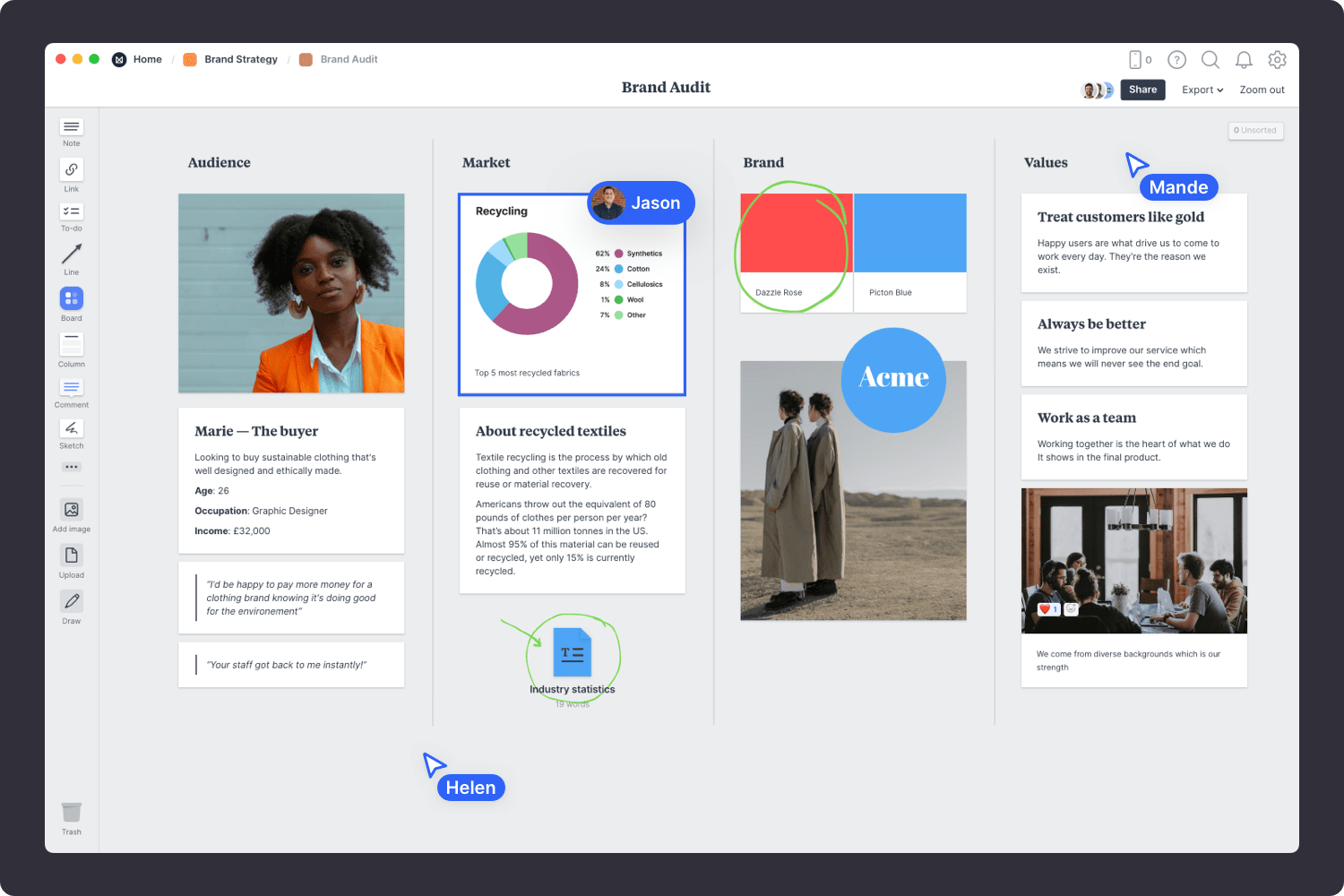
Open the Brand Audit board on your project plan.
Choose the Brand Audit template.
Each new board gives you the option to start with a beautiful template.
Add notes for insights and quotes.
Start typing then use the formatting tools in the left hand toolbar.
Upload images and documents to bring your data to life.
Click the "Upload" button or just drag a file onto your board. You can add images, logos, documents, videos, audio and much more.
Use Comment cards to start a conversation about the brand.
Drag out a comment from the toolbar on the left and place it on your board. Other editors can reply to your comment.
Read the full step-by-step guide: How to conduct a brand audit.
When creating a new brand or re-branding a company, it's crucial to have a crystal clear picture of your ideal customer. Building a customer persona is the best way to do this. It helps your design team understand exactly who they're designing for. Customer personas (or buyer personas) are fictional, composite characters that represent a segment of your audience.
Good personas are built on real data and insights. They're a true representation of your ideal customer or a key segment, not a made-up character. There are lots of great places to find information for your persona—including your website analytics, recent surveys or real-life conversations with customers. Quotes from actual customers can really help bring your research to life. Start by collecting everything in one place.
Next, describe your customer's needs & pain points. This allows you to identify how your objectives can align with the interests of your customer. Pain points are just as important, as removing these challenges will likely be the key to winning your customer's loyalty.
Now you have a clear understanding of your customer's goals, background and pain-points so you can design a brand that naturally appeals to them. Be sure to reference your persona throughout the project and ensure you're still on track.
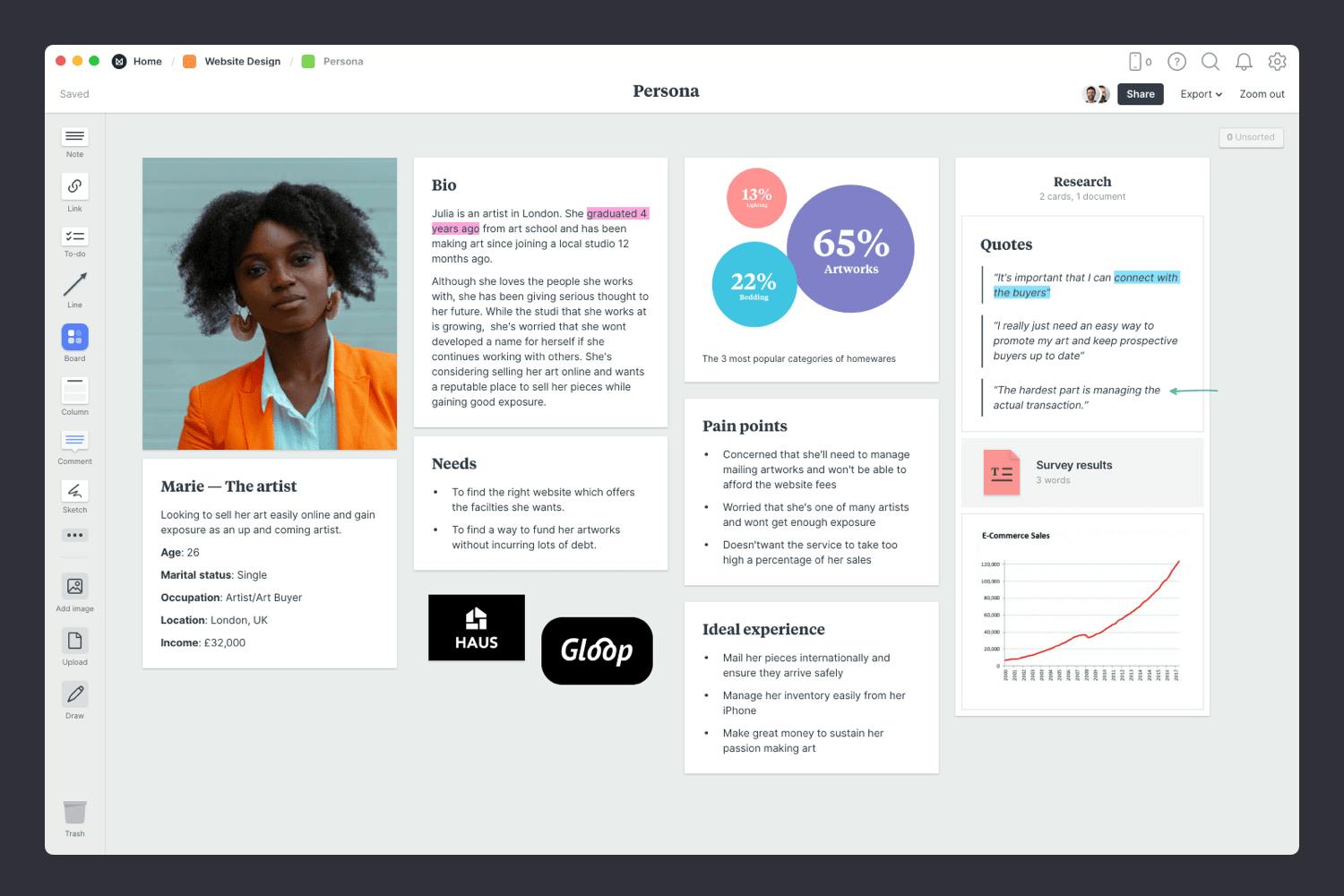
Open the Target Audience board on your project plan.
Choose the Customer Persona template.
Each new board gives you the option to start with a beautiful template.
Add notes to highlight insights and quotes.
Start typing then use the formatting tools in the left hand toolbar.
Upload images and documents to bring your data to life.
Click the "Upload" button or just drag a file onto your board. You can add images, logos, documents, videos, audio and much more.
Read the full step-by-step guide: How to visualize your ideal customer.
One of the most important goals when designing a new brand is to create something that's unique. Something that stands out against your competitors. But to do that, you first need to know what your market looks like. The Competitive Landscape framework is perfect for identifying your opportunity in the market. It's a technique that helps you identify your closest competitors and carve out a space in the market to plant your flag.
First, setup up a simple axis to compare the companies in your market. You can compare your market through any lens, but in this example, we'll use brand personality and price (playful vs formal and affordable vs high-end). There are no strict rules, you can compare any attribute you like. You might want to map out your competitors based on market share, features or audience.
Next, brainstorm all your direct and indirect competitors and add their names or logos to the position your think best represents them. If you're designing a new brand, mapping out your competitor's logos is the perfect way to see how to differentiate your brand. Observe the colours, fonts and styles your competitors use.
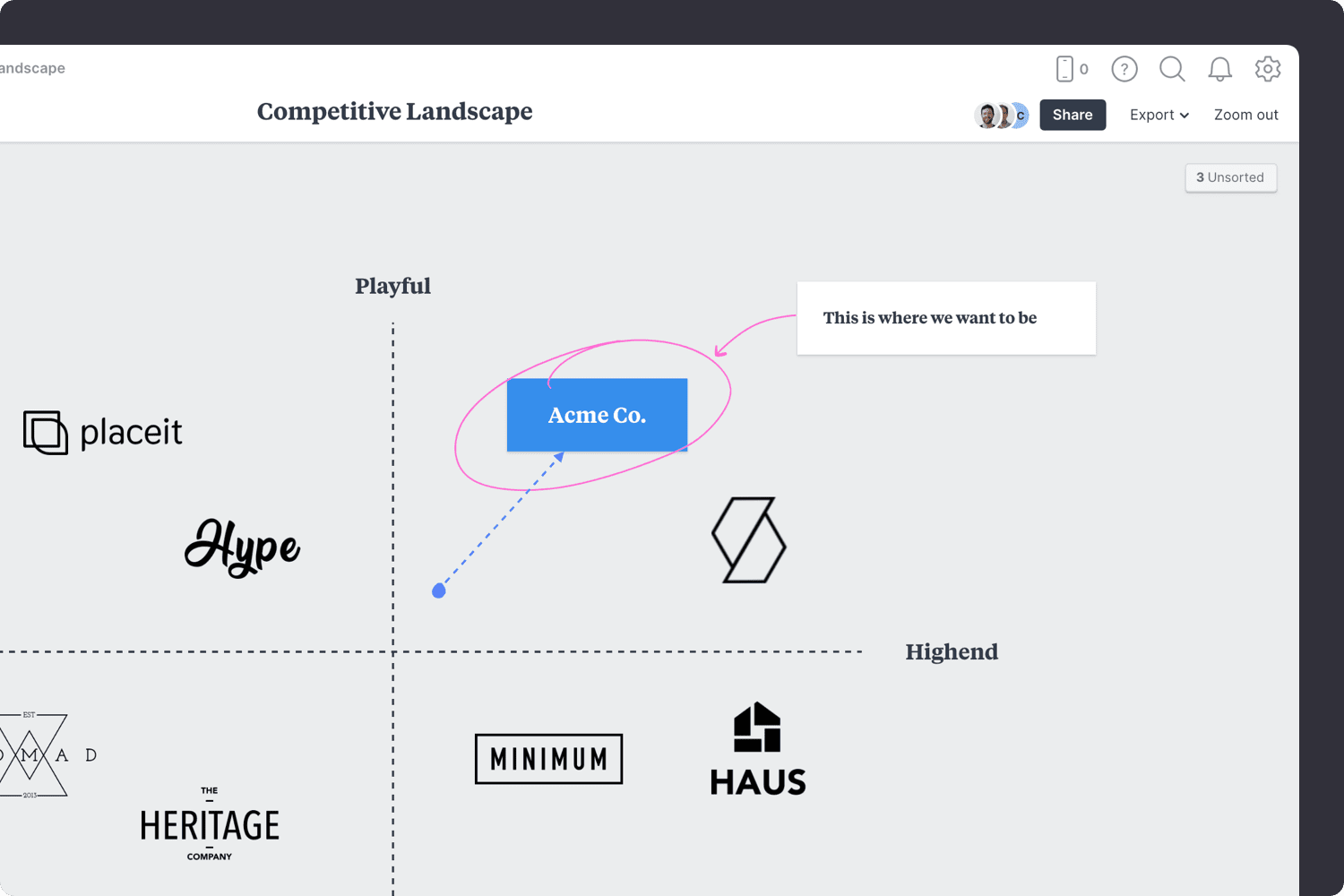
Open the Competitive Landscape board on your project plan.
Choose the Competitive Landscape template.
Each new board gives you the option to start with a beautiful template.
Add your competitor's logos or names
Click the "Upload" button or just drag a file onto your board. You can add images, logos, documents, videos, audio and much more.
Markup notes and insights on your map
Click Draw in the lefthand toolbar to sketch anywhere on a board. Press Save to commit a sketch.
Read the full step-by-step guide: How to map out your competitive landscape.
Is your brand cheeky and bold? Or rational and mature? This is where you define the personality of your brand—as if it was a character.
The brand personality is a set of adjectives that describes how you want to be viewed by your audience. It will become an important reference when developing a brand name and visual style. It will help you answer questions like; does this color palette fit with our brand personality? Or, is this tone of voice too quirky for our brand?
Start with the characteristics defined in the Brand Personality template and update it to fit your brand. Then, define where you sit on each scale. It's best to do this exercize as a group. Everyone will have an opinion. Add comments to the board and debate each adjective until you have a unique brand personality that suits your audience and stands apart from your competitors.

Open the Brand Personality board on your project plan.
Choose the Brand Personality template.
Each new board gives you the option to start with a beautiful template.
Add Notes for each brand characteristic.
Start typing then use the formatting tools in the left hand toolbar.
Start a conversation about your brand personality.
Drag out a comment from the toolbar on the left and place it on your board. Other editors can reply to your comment.
Once you've completed the research activities, it's time to move on to the creative parts of your brand strategy. First, creating a memorable, unique name. Creating a brand name from scratch can feel like a daunting task. Luckily, there's a process that brand strategists use to come up with unique, creative names.
Begin by creating a few categories or themes to explore. Here's a list of the common types of brand names you can use as a starting point:
Time to start brainstorming. Add as many as you can to the board and on ideas that others have added. Don't worry about evaluating your ideas yet, that will come later.
Finally, pick your top 3 and evaluate them. See if you're allowed to use the name before you get too attached. Is the ".com" available? Is your ideal name already trademarked? Try saying it in a conversation. Ensure it's easy to spell and remember. It's critical to run this evaluation before presenting the name to a client or getting others excited about it.
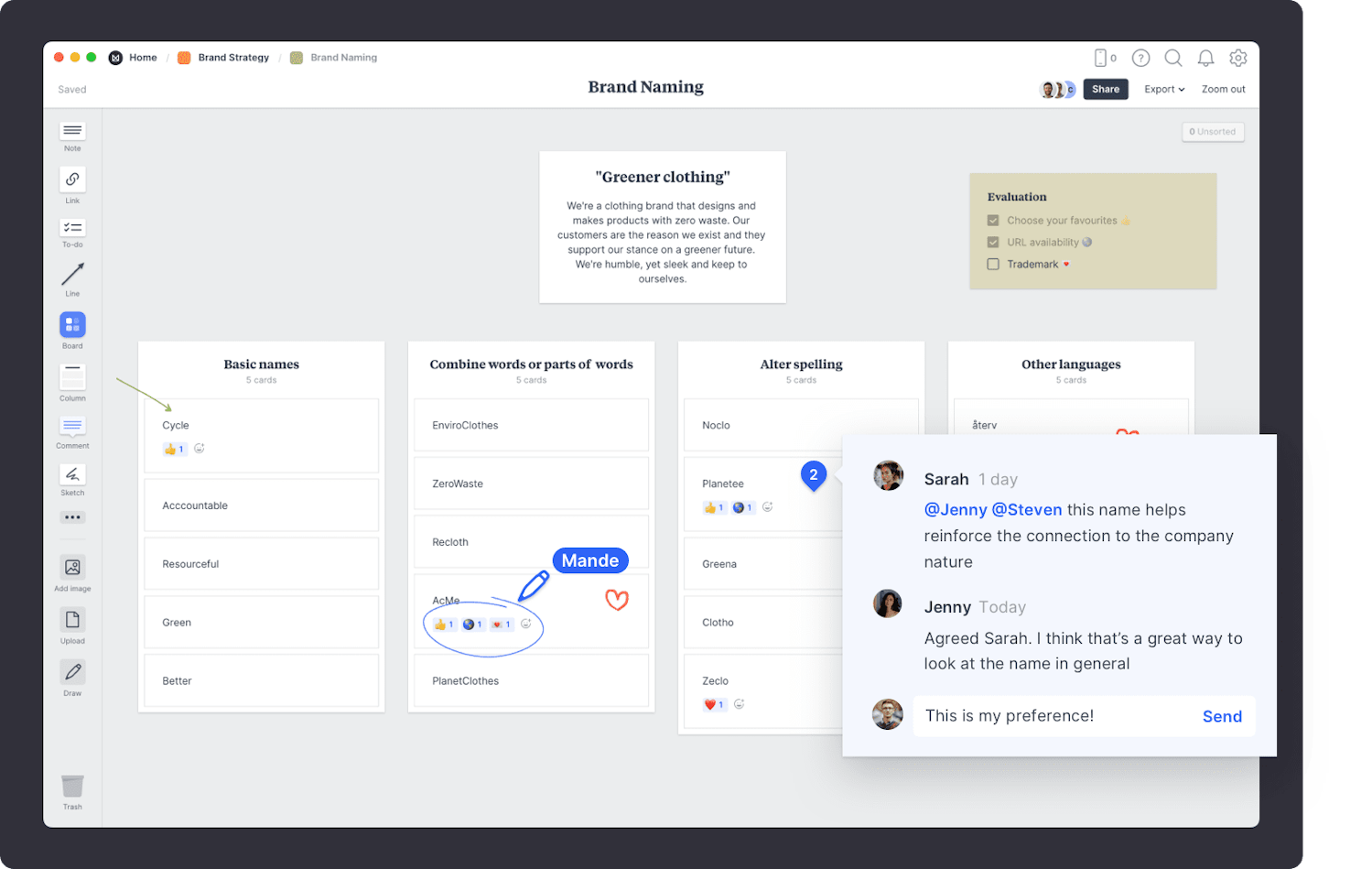
Open the Brand Naming board on your project plan.
Choose the Brand Naming template.
Each new board gives you the option to start with a beautiful template.
Add Columns to create a framework for ideas
Name it, then drag any relevant notes, images or boards into your column to stay organized.
Add a Note Card for each name idea
Start typing then use the formatting tools in the left hand toolbar.
Use Comment cards to start a conversation.
Drag out a comment from the toolbar on the left and place it on your board. Other editors can reply to your comment.
Read the full step-by-step guide: How to come up with a brand name.
Finally, it's time to bring all the strategy and thinking together as a moodboard. A moodboard is a collection of visual materials that evoke a certain style or concept. They're a great way to communicate the "feel" of the brand before you start designing the logo and visual assets.
Brand moodboards usually includes inspiration and visual references for imagery, fonts, color, patterns and even example logos. Start by searching for visual elements from around the web and add them to your board. There are lots of fantastic sites where you can find great visual inspiration for free, like Dribbble, Behance and Designspiration.
When your moodboard is done, it's time to share it with your team or client. Ask for specific feedback on color, tone, imagery, and type. This is the perfect time to ensure the design team and the client are on the same page.
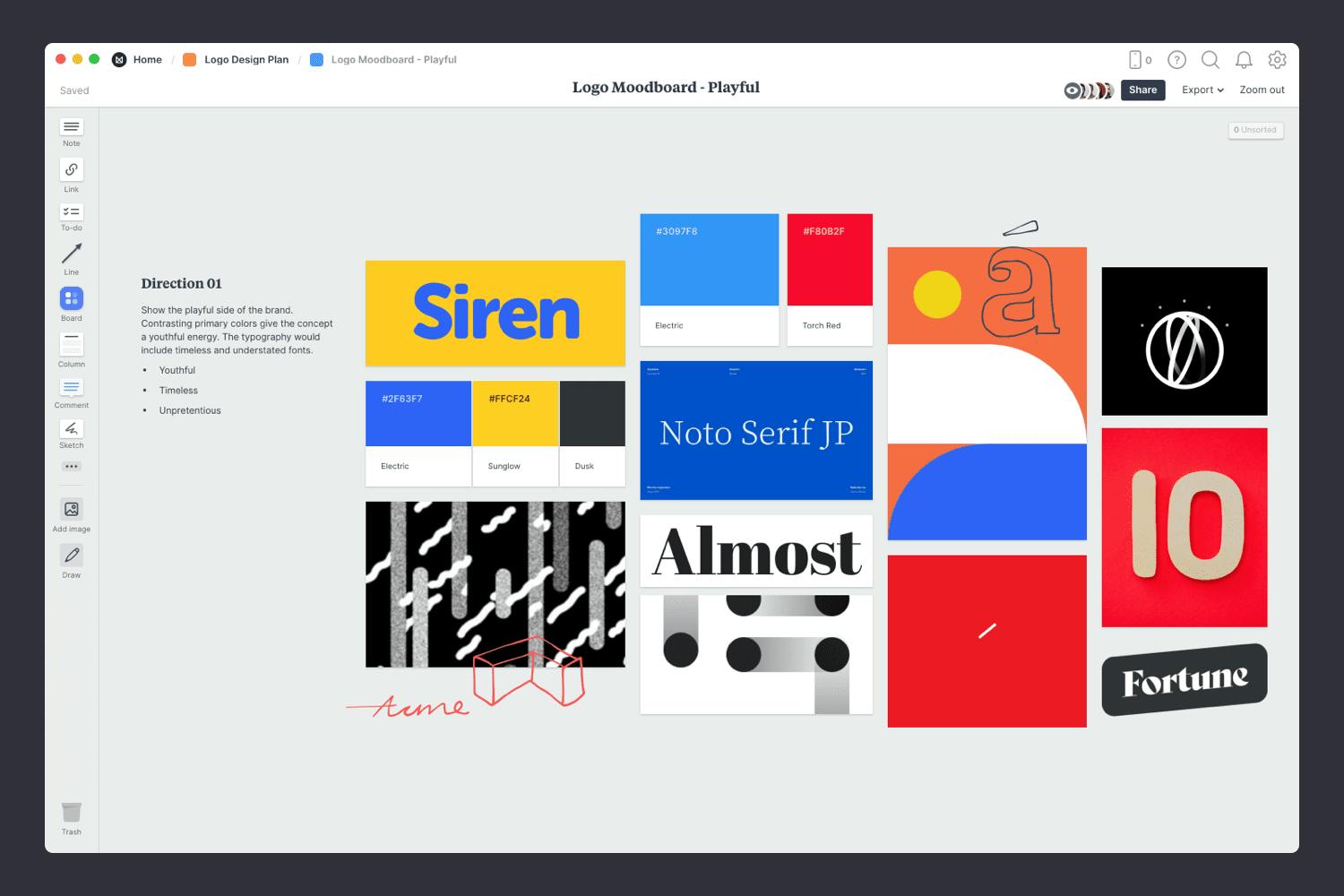
Open the Moodboard on your project plan.
Choose the Moodboard template to save time.
Each new board gives you the option to start with a beautiful template.
Use the built-in image library.
Search over 3 million beautiful, free photos then drag images straight onto your board. Powered by Pexels.
Add a color swatch to a board.
Drag a Color Swatch card onto your board from the left-hand toolbar. Double-click the swatch to choose a different color.
Add a Note to explain your thinking.
Start typing then use the formatting tools in the left hand toolbar.
Read the full step-by-step guide: How to make a moodboard in minutes.
Hopefully this guide has helped you become more organized (and creative) during a brand strategy project. If you're just starting a new project, use the Brand Strategy template below to get set up in minutes. Every project is unique, so customize the activities and content to suit your workflow.